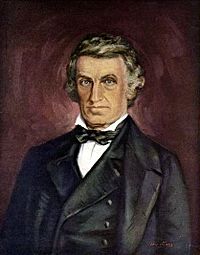William Beaumont facts for kids
Quick facts for kids
William Beaumont
|
|
|---|---|

William Beaumont
|
|
| Born | November 21, 1785 Lebanon, Connecticut, U.S.
|
| Died | April 25, 1853 (aged 67) |
| Resting place | Bellefontaine Cemetery |
| Nationality | United States |
| Known for | Research on digestion |
| Scientific career | |
| Fields | Medicine |
William Beaumont (born November 21, 1785 – died April 25, 1853) was an important surgeon in the U.S. Army. He is often called the "Father of Gastric Physiology" because of his amazing research into how the human body digests food.
Contents
William Beaumont's Life
Early Years and Army Service
William Beaumont was born in Lebanon, Connecticut. His father was a farmer. When William turned 21, he left home and became a teacher in Champlain, New York.
In 1810, he moved to St. Albans, Vermont. There, he learned to be a doctor by working with Dr. Truman Powell. In 1812, he passed his medical exams. He was recommended as a "judicious and safe practitioner."
From 1812 to 1815, Beaumont served as an assistant surgeon in the Army during the War of 1812. He helped in the Battle of Plattsburgh. After the war, he opened his own medical practice. But by 1820, he rejoined the Army as a surgeon. He was sent to Fort Mackinac. In 1821, he married Deborah "Debby" Green Platt.
The Amazing Discovery: Alexis St. Martin
On June 6, 1822, something extraordinary happened. A man named Alexis St. Martin was accidentally shot in the stomach. The shotgun blast left a big hole in his stomach. Dr. Beaumont treated him, but he thought St. Martin would not live.
However, St. Martin survived! But the hole, called a fistula, never fully closed. This meant Dr. Beaumont could actually see inside St. Martin's stomach. Since St. Martin could no longer work, Dr. Beaumont hired him as a handyman.
Experiments on Digestion
In 1825, Dr. Beaumont realized he had a unique chance to study digestion. He began to do experiments using St. Martin's stomach. Most experiments involved tying a piece of food to a string. He would then put the food through the hole into St. Martin's stomach. Every few hours, he would pull the food out to see how much it had been digested.
Beaumont also took samples of gastric acid (stomach acid) from St. Martin's stomach. He studied this acid carefully. Sometimes, St. Martin would leave, but Beaumont would find him to continue his important work.
Key Findings
Dr. Beaumont also used the stomach acid samples to "digest" food in cups outside the body. This led to a very important discovery. He found that stomach acid, not just the stomach's squeezing and mashing, was the main thing that broke down food. This showed that digestion was mostly a chemical process, not just a mechanical one.
In 1838, Beaumont published his findings in a book. It was called Experiments and Observations on the Gastric Juice, and the Physiology of Digestion. This book changed how people understood digestion forever.
Later Life and Death
After his famous experiments, Beaumont and St. Martin went their separate ways. Beaumont returned to St. Louis. He tried for many years to get St. Martin to move there, but it never happened.
William Beaumont died in 1853 in St. Louis, Missouri. He slipped on icy steps. He was buried in Bellefontaine Cemetery. His important papers are kept at Washington University in St. Louis.
William Beaumont's Legacy
Many places and institutions are named after William Beaumont to honor his contributions to medicine:
- Beaumont Elementary School in Green Bay, Wisconsin
- Beaumont High School in St. Louis, Missouri
- William Beaumont Hospital in Royal Oak, Michigan
- William Beaumont Hospital in Troy, Michigan
- William Beaumont Hospital in Grosse Pointe, Michigan
- William Beaumont Army Medical Center in El Paso, Texas (The dining hall there is named for Alexis St. Martin!)
- William Beaumont Elementary School in Waterford, Michigan
- Beaumont Highway in his hometown of Lebanon, Connecticut.
- Beaumont Hall at the State University of New York College at Plattsburgh.
- Beaumont Hill, a hill in Antarctica.
Selected Writings
- Beaumont, William. "Experiments and Observations on the Gastric Juice and the Physiology of Digestion." Plattsburgh: FF Allen, 1833.
Images for kids
See also
 In Spanish: William Beaumont para niños
In Spanish: William Beaumont para niños






